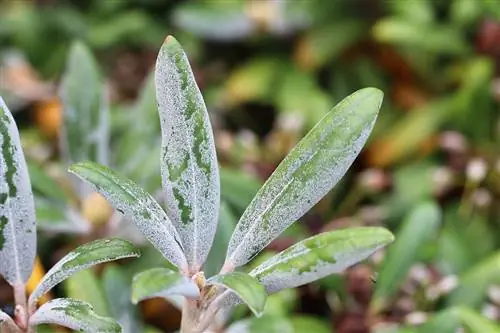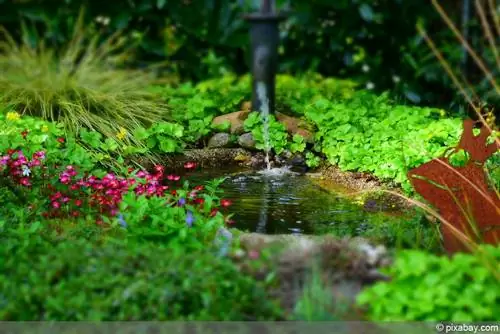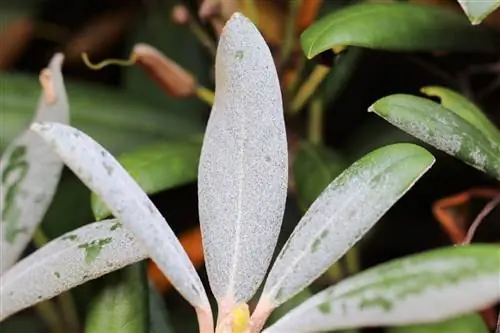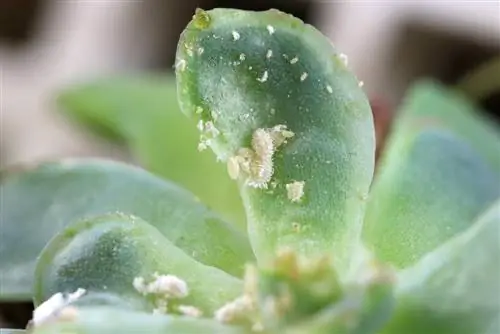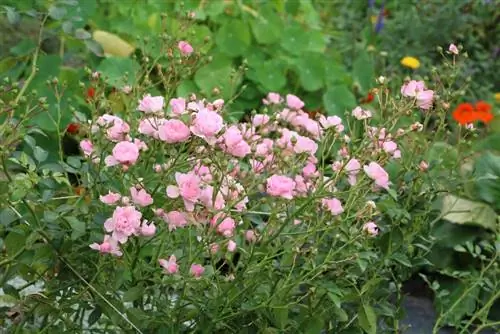- Author admin [email protected].
- Public 2023-12-17 03:39.
- Last modified 2025-01-24 12:45.
Mildew is one of the most feared fungal infections because it appears out of the blue and spreads quickly. Therefore, rapid action is required so that the infected plants have a chance of survival.
Mildew
Mildew represents a variety of pathogens that cause fungal diseases in plants. In the mushroom kingdom, the term is not a scientific name, as it includes mushrooms from different departments. So powdery mildew fungi (Erysiphaceae) are ascomycetes and downy mildews (Peronosporaceae) are egg fungi.
What both have in common is that they cover the plant with a fungal growth (film) that can lead to death if left untreated. Since not all home remedies help against powdery mildew and downy mildew, you will find features to identify mildew below.
Powdery mildew mushrooms
- white to yellowish-white coating on the upper side of the leaf
- in dry weather (fair weather mushroom), humid and warm temperatures and with strong temperature differences between day and night in autumn
- optimal distribution temperature: plus 20 degrees Celsius
- particularly susceptible plants (selection): roses, phlox, sunflowers, sweet peas, delphiniums, perennial aster, cucumbers, pumpkins, zucchini, peas, tomatoes, cinquefoil, hawthorn
Note:
Powdery mildew fungi are not particularly picky. In principle, there is a risk of infestation for all green plants.
Downy mildew fungi
- Underside of leaf: greyish-bluish to brown coating
- Top of leaf: yellowish to brown spots (mosaic pattern), e.g. T. also on stems and leaves
- in cool, damp conditions (bad weather fungus); in spring and autumn, in wet summers and in the glass house
- susceptible plants (selection): v. a. Herbaceous plants such as carnations, pansies, primroses, spinach, cucumbers; rare in woody plants with the exception of roses and vines
As the fungal infection progresses, the affected parts of the plant turn brown and die. Therefore, rapid action is required in the event of a mildew infestation.
Remedies against mildew fungi
The most proven remedy against powdery mildew infestation is to generously remove the infected plant parts in order to limit the spread of the pathogen. You should therefore cut off affected parts of the plant before using the various sprays. To prevent the mushrooms from spreading further after cutting them off, dispose of them in the household waste in a tightly closed plastic bag or burn them immediately. Under no circumstances should these be put in the compost.
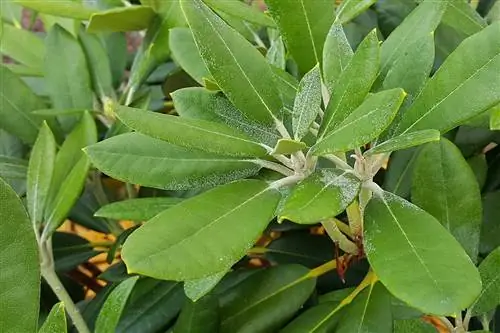
Various mixtures, broths, cold water withdrawals or plant extracts can be used as sprays against mildew fungi:
Blends
Baking soda-water mixture
- Ingredients: three teaspoons of baking soda, a drop of dishwashing liquid, one liter of water and ten milliliters of (rapeseed) oil
- Application: spray approximately every two weeks
- helps against: powdery mildew species
Milk-water mixture
- Ingredients: one part milk (ideally buttermilk or raw milk) and new part water
- Application: spray several times a week
- helps against: powdery mildew species
Soda-water mixture
- Ingredients: a packet of baking soda, two liters of water, 20 milliliters of oil
- Application: spray every two weeks
- helps against: powdery mildew species
Broths and extracts
Field horsetail decoction
- Ingredients: 300 grams of fresh or 30 grams of dried horsetails and two liters of water
- Preparation: Let water with horsetails steep for 24 hours, simmer on low heat for 30 minutes the next day, strain out plant parts, let the brew cool, let the broth rest for a few days (no more foam formation)
- Botting: one part horsetail to five parts water
- Application: spray several times at intervals of a few days; In case of severe infestation, once a day for three days
- helps against: real and downy mildew types
Anise extract
- Ingredients: 10 grams of dried leaves and a liter of water
- Preparation: Pour hot water (around 70 degrees Celsius) over the leaves, let them steep for several hours, strain, let cool
- Application: undiluted as irrigation water or for spraying
- helps against: real and downy mildew types
Stinging nettle broth
- Ingredients: about 100 grams of fresh nettle and a liter of water
- Preparation: Let the nettles steep in water for a few days, then bring to the boil, strain and let cool
- Botting: dilute with water in a ratio of 1:10
- Application: spray several times a day for a few days
- helps against: real and downy mildew types

Tip:
This recipe is also suitable for field horsetails.
Fern Broth
- Ingredients: 100 grams of fresh fern leaves (bracken or worm fern) or 10 to 20 grams of dried leaves, one liter of water
- Preparation: Let fern leaves steep in water for 24 hours, cook for 15 to 30 minutes the next day, strain
- Botting: no dilution necessary
- Application: spray at intervals of several days
- help against: downy mildew species
Fennel extract
- Ingredients: 10 grams of dried leaves and a liter of water
- Preparation: Pour hot water (around 70 degrees Celsius) over the leaves, let them steep for several hours, strain, let cool
- Application: undiluted as irrigation water or for spraying
- helps against: real and downy mildew types
Garlic stock
- Ingredients: four cloves of garlic (roughly chopped) and a liter of water
- Preparation: Pour boiling water over the garlic cloves; Let cool, strain garlic pieces
- Application: spray several times at intervals of a few days
- helps against: real and downy mildew types
Sakhalin knotweed extract
- Ingredients: 10 grams of dried leaves and a liter of water
- Preparation: Pour hot water (around 70 degrees Celsius) over the leaves, let them steep for several hours, strain, let cool
- Application: undiluted as irrigation water or for spraying
- helps against: real and downy mildew types
Yarrow Cold Water Detox
- Ingredients: 20 grams of dried yarrow flowers and a liter of water
- Preparation: Let yarrow flowers steep in water for 24 hours, then strain
- Botting: one part yarrow flower extract to nine parts water
- use as needed
- helps against: real and downy mildew types
Natural predators
In the fight against the various types of mildew, you will be particularly helpful
Ladybug
Ladybird larvae (available from specialist retailers)
Repellent plants
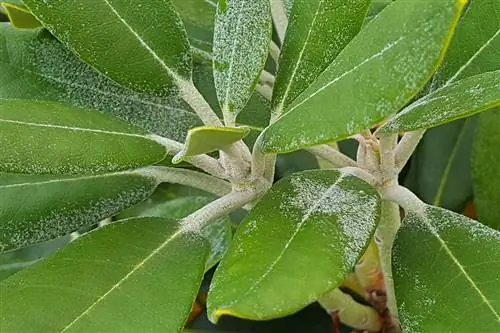
To protect susceptible plants in the garden bed, you should plant defensive plants evenly in the bed, such as:
- Basil (Ocimum basilicum)
- Chervil (Anthriscus cerefolium)
- Foxglove (Digitalis)
- Garlic (Allium sativum)
- Chives (Allium schoenoprasum)

